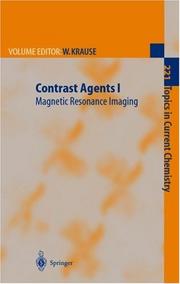| Listing 1 - 1 of 1 |
Sort by
|

ISSN: 03401022 ISBN: 3540422471 3540434518 354045733X 3540460098 9783540422471 9783540434511 Year: 2002 Volume: 222 Publisher: New York, NY ; Berlin : Springer-Verlag,
Abstract | Keywords | Export | Availability | Bookmark
 Loading...
Loading...Choose an application
- Reference Manager
- EndNote
- RefWorks (Direct export to RefWorks)
Extracellular MRI and X-ray contrast agents are characterized by their phar- cokinetic behaviour.After intravascular injection their plasma-level time curve is characeterized by two phases. The agents are rapidly distributed between plasma and interstitial spaces followed by renal elimination with a terminal half-live of approximatly 1–2 hours. They are excreted via the kidneys in unchanged form by glomerular filtration. Extracellular water-soluble contrast agents to be applied for X-ray imaging were introduced into clinical practice in 1923. Since that time they have proved to be most valuable tools in diagnostics.They contain iodine as the element of choice with a sufficiently high atomic weight difference to organic tissue. As positive contrast agents their attenuation of radiation is higher compared with the attenuation of the surrounding tissue. By this contrast enhancement X-ray diagnostics could be improved dramatically. In 2,4,6-triiodobenzoic acid derivatives iodine is firmly bound. Nowadays diamides of the 2,4,6-triiodo-5-acylamino-isophthalic acid like iopromide (Ultravist, Fig. 1) are used as non-ionic (neutral) X-ray contrast agents in most cases [1].
Analytical chemistry. --- Chemistry/Food Science, general. --- Contrast media (Diagnostic imaging) --- 543.422.25 --- #WSCH:AAS1 --- 543.422.25 Using high frequency electromagnetic waves (radio waves). Nuclear manetic resonance spectroscopy. NMR spectroscopy --- Using high frequency electromagnetic waves (radio waves). Nuclear manetic resonance spectroscopy. NMR spectroscopy --- Chemistry. --- Internal medicine. --- Physical chemistry. --- Organic chemistry. --- Science, Humanities and Social Sciences, multidisciplinary. --- Internal Medicine. --- Analytical Chemistry. --- Physical Chemistry. --- Organic Chemistry. --- Organic chemistry --- Chemistry --- Chemistry, Theoretical --- Physical chemistry --- Theoretical chemistry --- Analysis, Chemical --- Analytic chemistry --- Chemical analysis --- Chemistry, Analytic --- Medicine, Internal --- Medicine --- Physical sciences --- Materials science. --- Biochemistry. --- Laboratory medicine. --- Characterization and Evaluation of Materials. --- Biochemistry, general. --- Laboratory Medicine. --- Clinical medicine --- Clinical pathology --- Diagnostic laboratory tests --- Laboratory diagnosis --- Laboratory medicine --- Medical laboratory diagnosis --- Diagnosis --- Pathology --- Biological chemistry --- Chemical composition of organisms --- Organisms --- Physiological chemistry --- Biology --- Medical sciences --- Material science --- Composition --- Radiography, contrast agents
| Listing 1 - 1 of 1 |
Sort by
|

 Search
Search Feedback
Feedback About UniCat
About UniCat  Help
Help News
News